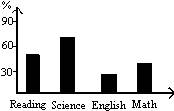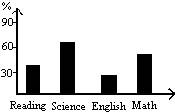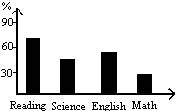题目内容
Without the atmosphere there would be no weather, no wind, rain, snow, or clouds. Air is all around us; we live at the bottom of a great ocean of air. It is invisible, but we can feel it when it moves. There are miles of air above us, pressing down with great weight on the earth and everything on it. Because air presses down on us from all directions at the same time, and because we are able to bear (忍受) this weight, we do not seem to feel it. But scientists have proved that air has this weight, and that anything that has weight creates(产生) a force called pressure. As changes in air pressure take place, they, make air move.
Air is a gas that expands(膨胀) when heated, gets lighter, and moves upward. When air is cooled, it gets heavier, sinks close to the earth's surface, and flows like water in a great river. As warn air rises, cold air rushes in to take its place. 'Thus winds originate (起源). The winds that blow high above us are caused by the warmer air running away from colder air. The wind we feel near the earth's surface is the heavy colder air trying hard to catch the warmer air. Changes in temperature cause the air to move. And of course there are many changes, so air movements are taking place practically all the time.
小题1:The first paragraph mainly tells us the causes of
| A.why we don't feel air | B.why atmosphere is important to us |
| C.why there is air surrounding us | D.why there is air pressure |
| A.there is air pressure | B.the air is heavy |
| C.air pressure doesn't remain the same all the time | D.air comes up and down |
小题4:According to the passage, in same areas if farmers who grow grapes (葡萄) light fires in the early morning, that is because the farmers want to________________.
| A.drive away warm air | B.prevent cold air from coming to harm their plants |
| C.cause more wind | D.stop warm air running away |
小题1:A
小题2:C
小题3:B
小题4:B
小题1:
小题2:
小题3:
小题4:

练习册系列答案
相关题目
 omes. They think that they are left in the (36) of strangers for the rest of their lives. Their (37) children visit them only occasionally, but more often, they do not have any (38) visitors. They live a lonely life without anyone’s care. The truth is that this idea is an unfortunate myth and (39) story. In fact, family members provide over 80 percent of such care (40) elderly people need. They are still living in a familiar family. Samuel Prestoon, a sociologist, studied (41) the American family is changing. He reported that by the time the (42) American couple reaches 40 years of age, they have more parents than children. However, because people today live longer after an illness than people did years (43) , family members must provide long term care. We know, people need company, (44) the elderly people.
omes. They think that they are left in the (36) of strangers for the rest of their lives. Their (37) children visit them only occasionally, but more often, they do not have any (38) visitors. They live a lonely life without anyone’s care. The truth is that this idea is an unfortunate myth and (39) story. In fact, family members provide over 80 percent of such care (40) elderly people need. They are still living in a familiar family. Samuel Prestoon, a sociologist, studied (41) the American family is changing. He reported that by the time the (42) American couple reaches 40 years of age, they have more parents than children. However, because people today live longer after an illness than people did years (43) , family members must provide long term care. We know, people need company, (44) the elderly people. B.
B.
 D.
D.
 T-shirt and then shouted, "Are they wet enough now?"
T-shirt and then shouted, "Are they wet enough now?" n the sports field.
n the sports field. The museum of Childhood is housed in a large Victorian building in east London. It has been on this site since 1872. It has undergone refurbishment (翻新) and reopened in 2006 and an elevator now makes all floors accessible.
The museum of Childhood is housed in a large Victorian building in east London. It has been on this site since 1872. It has undergone refurbishment (翻新) and reopened in 2006 and an elevator now makes all floors accessible. This is not a quiet place and children are allowed to have fun here. Child safety is extremely important and a member of staff remains by the front door at all times. Also, note the “Code of Behavior” notice, which includes: children under 12 must be supervised by an adult; no eating in the galleries and no running.
This is not a quiet place and children are allowed to have fun here. Child safety is extremely important and a member of staff remains by the front door at all times. Also, note the “Code of Behavior” notice, which includes: children under 12 must be supervised by an adult; no eating in the galleries and no running. Visit Duration: 1.5 hours
Visit Duration: 1.5 hours